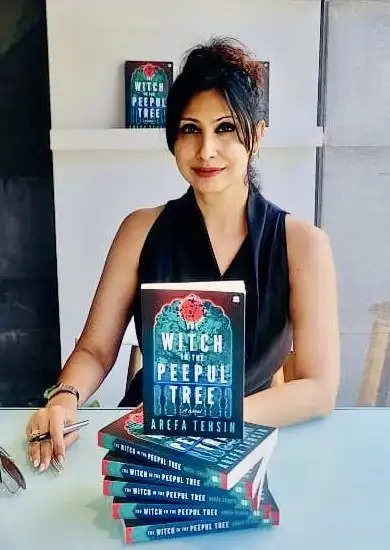Book Review: The Witch in the Peepul Tree - Arefa Tehsin
This is first novel for adults by acclaimed children's book author Arefa Tehsin of Udaipur
“The Witch in the Peepul Tree” is the debut novel for adults by acclaimed children’s book writer Arefa Tehsin, who hails from Udaipur. The book takes you through the narrow bylanes of the walled city of Udaipur of the 1950’s. The nuanced description of the life and times of the almost forgotten era will make the readers of Udaipur realize how much the city has changed in the last 75 years. The socio-economic and political background of the society of the 50’s has been brilliantly captured by Tehsin.

An intriguing murder mystery, revolving around the death of sixteen year old Sanaz, daughter of the rich and reputed Dada Bhai and Mena Bai, on the auspicious day of Makar Sankranti in 1950.
The engaging story details the sinister happenings during the 24 hours of the night and day of Makar Sankranti. The youngest son, Ahad, discovers the lifeless body of his sister in her room in Dada Bhai’s palatial house or ‘kharki’, in the Bohrawadi area of Udaipur. Ahad believes that the ‘Jeevti Dakkan’, the resident witch of the peepul tree in the backyard of the ‘kharki’, has taken away Sanaz Aapa.
The list of murder suspects interrogated by Inspector Tapan Singh includes the visiting feudal lord ‘Zamindar’ Rao Singh, the ‘bhil’ tribal Nathu, the muslim house boy Ismail, the ‘baniya’ middleman Hariharan, the low caste sweeper Parijat, the muslim house-keeper Badi Bi and the father, an aristocrat and well-respected bohra, ‘Dada Bhai’ Tahir.
Tehsin has successfully managed to highlight the oppression of the underprivileged (based on caste system, power and money) through the heart-wrenching stories of Parijat, the low caste sweeper, and Nathu, the tribal. She has also effectively highlighted the age-old customs of ‘Iddat’ and ‘Khatna’ prevalent in the Bohra society, as a sub plot of the murder mystery, making the book a compulsive read.
The ‘sevaiyan’ making process of the muslim ladies on the terraces of Bohra households and the Gavari folk dance by the tribals in the villages of the Mewar region are memories of my childhood that have resided in some forgotten corner of my brain, and when I read about them in such great detail, it made me extremely nostalgic. Another instance, where Tehsin highlighted the habit of nicknaming fellow ‘Bohras’ - for example, ‘Vichuda’ Kamar or Kamar the scorpion - left me in splits.
Tehsin’s narration of the hunting trips of Dada Bhai and Rao Sahib in the jungles of the Aravallis, covering the minute details of the flora and fauna of the region 75 years ago, shows how well-researched her work is.
I found it a captivating and fun read, but since it is set in a bygone era, many of the situations and customs described aren’t common practice anymore. However, the lessons to take from it are still relevant and powerful. I’m looking forward to reading more books by this fine author.
To join us on Facebook Click Here and Subscribe to UdaipurTimes Broadcast channels on GoogleNews | Telegram | Signal



